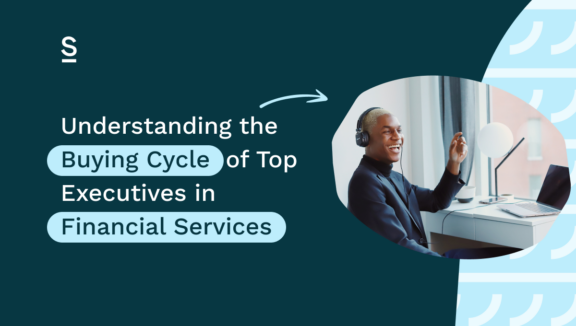Understanding the Buying Cycle of Top Executives in Financial Services

You’re a sales professional targeting top executives in the financial services industry. Every day you skip into work, say hello to your friends, pick up the phone, and get selling. Closing deals is easy in this sector – everyone you speak to is ready to buy, and confident that you’re the person to buy from. Your manager loves you, your CEO loves you, your teammates love you – you’re just that good.
Oh yeah – and pigs can fly, right?
Here’s the thing: you might be the most accomplished salesperson in the world, but if you’re in the financial services industry it’s likely that you’ve got some long and complicated sales processes to deal with.
There’s no getting around it – but what you can do is take the time to truly understand these buying cycles. Do so, and you’ll make sure that you pitch at the right time of year, and get ahead of your competition well in advance of decision-making time.
And helping you do just that is exactly why we’ve written this blog post. We’ll be covering:
- An Overview of the Buying Cycle
- Identifying the Stages of the Buying Cycle
- Aligning Your Sales Strategy with Each Stage
- Common Challenges and How to Overcome Them
- Adapting to Changing Buying Cycles
Ready to become a buying cycle master? Let’s get into it.
Overview of the Buying Cycle
A buying cycle is a journey – more specifically, a journey that a customer takes from recognizing they have a problem right through to purchasing a solution and beyond.
These tend to be particularly long in B2B sales – where the return on every investment has to be carefully calculated, and deals run into tens or even hundreds of thousands of dollars – and they’re getting longer. 43% of B2B sales leaders reported an increase in sales cycle length over the past 12 months.
The same is most definitely true of financial services industry sales cycles, for the following reasons:
Regulatory and compliance considerations: the financial services industry has strict regulations and compliance requirements, meaning that purchasing decisions have to go through an extensive vetting process.
Multi-stakeholder decision-making: financial services firms tend to be large and complex, especially those with high net-worth financial advisors. The more departments participate in the decision-making process, the longer your sales cycle is likely to be.
High stakes and risk aversion: firms in the sector have to be conscious of their stability and reputation, which can make top executives risk-averse. This doesn’t mean you’ll never sell anything ever again, but it does mean you can expect extensive due diligence before getting a commitment.
Stages of the Buying Cycle
Let’s run through what a buying cycle actually looks like in the financial services industry. Note that these will, of course, vary slightly depending on the unique product you’re selling and who you’re selling it to.
Awareness: stage one. The executive first becomes aware of a problem that needs a solution.
Consideration: now, your executive is actively looking at different solutions. These might be different options that your business provides, or maybe they’re considering a few different providers.
Evaluation: here, the executive will be actively digging into and weighing up their options and vendors.
Decision: it’s crunch time – the buying group’s been consulted, the ROI’s been calculated, and your executive is going to sign on the dotted line. Fingers crossed!
Post-purchase: here’s the CS team’s time to shine; it’s their job to convince the executive to renew or re-purchase later down the line.
Identifying the Stages of the Buying Cycle
You should be fully aware of the buying cycle stage of every prospect, to make sure you’re providing the right information, additional content, and support. Signals to watch out for at each stage include:
Awareness: the executive might start interacting with content to do with industry trends, regulatory changes, or challenges. This could be on LinkedIn, on your website, or in meetings or public forums.
Consideration: here you might start receiving requests for information or calls – or you might meet your executive while you’re exhibiting at a trade show, for example.
Evaluation: by now, the buyer should be requesting detailed bottom-of-funnel content – things like case studies or demo videos – and you should be engaging with multiple departments, like IT and compliance.
Decision: you’ll be entering the final negotiation stage. This means speaking to more senior executives or waiting for your contact to hear back from the board. If everything’s going well, you’ll also be discussing implementation timelines and next steps.
Post-purchase evaluation: the deal went through – woo! Later down the line, the executive will have to evaluate how your solution has performed against their expectations. Your CS team will receive feedback, and if all is well, start working towards a renewal or repurchase.
You’ll use information gained from content engagement, conversations you have, and buyer intent data – more on that in a minute, btw – to understand where they are in the sales cycle. Ideally, you want to automate as many of these insights as possible and feed them through to a centralized place.
If you’re wondering what on earth that means, keep reading:
Tools and Techniques for Stage Identification
Let’s dig a little deeper into the tools and techniques that are going to make your (professional) life a breeze:
Your CRM: remember that centralized space we just spoke about? (That’s a rhetorical question. We know you’re paying attention 😉). You’ll want to have all your buyer insights and data right here. Having it in one place will make it easier to see what’s going on and who’s where in the buying cycle. The right CRM should even be able to build your data into a handy dashboard.
Content engagement: this could be something you pull from your website data or email results. For example, a prospect could have visited a case study page 5 times in the same afternoon, or maybe they click through in an email you send with a link to a useful article. It might even be as direct as the prospect asking you to send over testimonials or explanatory content.
Buyer intent data: there are two types here. First-party data is the stuff you hear from the horse’s mouth. Or in sales terms, from the prospect’s actions – the aforementioned visits to your website, or what they tell you on a call, for example. Third-party data is provided by – you guessed it – third-party providers like data providers or industry-specific platforms.
Account-based marketing
By now, it should be pretty clear that, when targeting top executives in the financial services industry, you’ll more likely than not need to keep a very close eye on their progression through the cycle.
Keeping this close eye, along with creating personalized buying experiences off the back of what you learn, is known as account-based marketing (ABM). It’s a well-known strategy used for high-value accounts – and often results in higher close rates and improved customer relationships to boot.
A well-thought-out ABM strategy usually begins with targeted content delivery. Engagements and insights need to be tracked carefully, so the team can then send personalized outreach and follow-ups created off the back of them. Simple!
Aligning Your Sales Strategy with Each Stage
Next up, let’s look at bringing it all together. What should your goal be for each awareness stage, and what strategies should you use to meet that goal?
Awareness Stage
Your goal: here, it’s all about generating interest and establishing your solution’s credibility from the get-go.
Strategies to get there: this might look like sharing thought leadership content, or employing your best social selling skills on LinkedIn to position yourself as a trusted advisor. Topics to discuss include potential challenges and industry trends.
Consideration Stage
Your goal: so, your executive knows about your solution. How do you make it seem like a viable option?
Strategies to get there: this is where your content really comes into its own. Share case studies, white papers, and detailed product information (a walkthrough video, for example). Now’s the time to invite your executive to a webinar or a one-on-one meeting to show how your solution can help them.
Evaluation Stage
Your goal: ok, so your solution seems viable, but…so do your competitors. What do you do to differentiate?
Strategies to get there: offer tailored demos, detailed ROI analysis, and testimonials from similar financial services customers. You want these to focus on addressing objections and reinforcing the unique value of your solution.
Decision Stage
Your goal: now, it’s time to make your prospect’s life as easy as possible. You wouldn’t want to fall at the final hurdle, would you?
Strategies to get there: make sure your pricing and contract terms are super-easy to understand. You’ll also want to be confident that all decision-makers are aligned and any final concerns are answered promptly.
Post-purchase Stage
Your goal: make sure your new client is fully satisfied, and lay the groundwork for a long-term, fruitful relationship.
Strategies to get there: don’t just wash your hands of the sale as soon as it’s done. Provide full onboarding support and make sure your CS team knows everything they have to. They’ll want to gather feedback as soon as they start, so they can identify opportunities for cross-selling.
Common Challenges and How to Overcome Them
Ok, so you know what you have to do in theory…but what happens when a curveball comes your way?
Challenge 1: Extended Buying Cycles
28% of sales pros cite lengthy sales cycles as the top reason prospects back out of sales deals. That’s not a statistic you want to be a part of!
Your sales cycles are always going to be longer, thanks to strict regulations and compliance standards your prospects have to follow. New solutions will have to be assessed by multiple departments to make sure they align with operational goals and regulatory standards.
To maintain momentum, provide tailored insights such as how your solution addresses specific regulations, and keep all stakeholders engaged through regular updates, case studies, and tailored demos.
Challenge 2: Multiple Decision-Makers
So, you’ve got a lot of stakeholders to handle. This buying group might be a formal team that’s been set up to decide on the purchase decision, or it might be an informal network. For example, you might not hear anything about a senior executive until halfway through the process, when your prospect suddenly mentions their buy-in is crucial.
Make sure you’re asking the right questions to understand who you need to have onboard. You’ll also want to provide role-specific content (a CFO will be interested in different aspects from a CMO, for example.
Challenge 3: Regulatory and Compliance Considerations
In financial services, regulatory requirements like those from the SEC or Federal Reserve can make the buying cycle even more complicated. Your role is to position your solution as compliant with relevant regulations and beneficial from the start. Clear documentation, case studies, and testimonials will do the trick here.
Adapting to Changing Buying Cycles
Buying cycles are going to change: guaranteed. Here’s how to keep on top of it:
Monitoring and Adjusting Your Approach
You want to continuously monitor the executive’s progress through the buying cycle. Why? Well, if things don’t seem right – perhaps they’re moving more slowly than your other prospects, for example – now’s the time to switch things up.
This may be something as direct as reaching out to ask how you can help or sending additional content to keep them engaged.
External factors like economic changes or new regulations can also have an impact. Make sure to keep on top of all your industry news, and think about how you can use it to your advantage.
Leveraging Feedback for Continuous Improvement
After each stage make sure you’re collecting feedback. This is not only going to inform how you approach the next stage, but also help you better predict and navigate the buying cycle of other executives in the industry.
Qualitative feedback, when combined with quantitative data you’ve already collected, will paint the most complete picture of your buying cycle.
Let’s Wrap It Up!
Hey – is that a flying pig?
Turns out, guiding financial services executives through the buying cycle isn’t as difficult as you expect. Stick to the steps outlined above, and you’ll enjoy shortened sales cycles that you feel totally in control of. Sounds like a good deal to us – and we bet your prospects will like it too.

Ready to start managing top executives through the sales cycle?
First, you need Surfe to find them. Start for free today – we promise it’s worth it.


